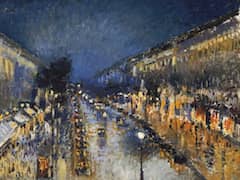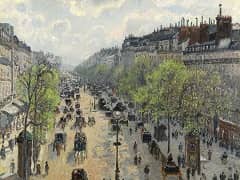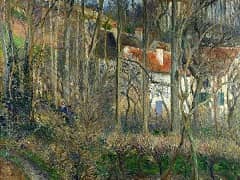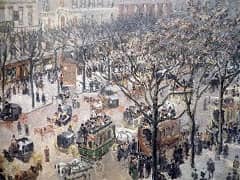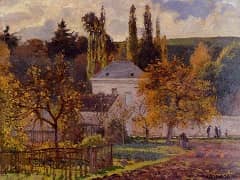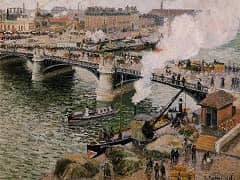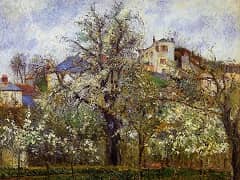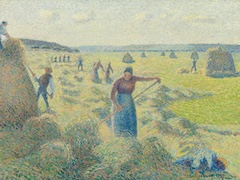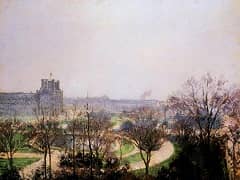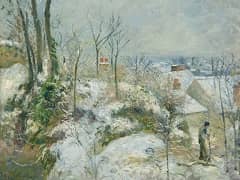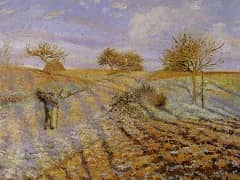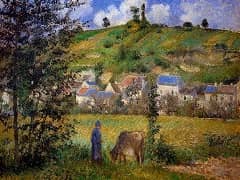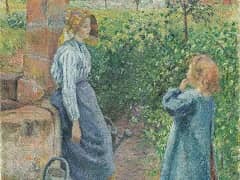Camille Pissarro and Impressionism
Impressionism is a 19th-century art movement that originated with a group of Paris-based artists. Their independent exhibitions brought them to prominence during the 1870s and 1880s, in spite of harsh opposition from the
conventional art community in France. The name of the style derives from the title of a Claude Monet work, Impression, Sunrise,
which provoked the critic Louis Leroy to coin the term in a satirical review published in the Parisian newspaper Le Charivari.
Impressionist painting characteristics include relatively small, thin, yet visible brush strokes, open composition, emphasis on accurate depiction of light in its changing qualities (often accentuating the effects of the passage
of time), ordinary subject matter, inclusion of movement as a crucial element of human perception and experience, and unusual visual angles. The development of Impressionism in the visual arts was soon followed by analogous styles
in other media that became known as impressionist music and impressionist literature.
Overview
Radicals in their time, early Impressionists violated the rules of academic painting. They constructed their pictures from freely brushed colours that took precedence over lines and contours, following the example of painters
such as Eugene Delacroix and J. M. W. Turner. They also painted realistic scenes of modern life, and often painted outdoors. Previously, still lifes and portraits as well as landscapes
were usually painted in a studio. The Impressionists found that they could capture the momentary and transient effects of sunlight by painting en plein air. They portrayed overall visual effects instead of details, and used short
"broken" brush strokes of mixed and pure unmixed colour - not blended smoothly or shaded, as was customary - to achieve an effect of intense colour vibration.
Impressionism emerged in France at the same time that a number of other painters, including the Italian artists known as the Macchiaioli, and Winslow Homer in the United States, were also
exploring plein-air painting. The Impressionists, however, developed new techniques specific to the style. Encompassing what its adherents argued was a different way of seeing, it is an art of immediacy and movement, of candid
poses and compositions, of the play of light expressed in a bright and varied use of colour.
The public, at first hostile, gradually came to believe that the Impressionists had captured a fresh and original vision, even if the art critics and art establishment disapproved of the new style.
By recreating the sensation in the eye that views the subject, rather than delineating the details of the subject, and by creating a welter of techniques and forms, Impressionism is a precursor of various painting styles,
including Neo-Impressionism, Post-Impressionism, Fauvism, and Cubism.
Beginnings
In the middle of the 19th century - a time of change, as Emperor Napoleon III rebuilt Paris and waged war - the Academie des Beaux-Arts dominated French art. The Academie was the preserver of traditional French painting standards
of content and style. Historical subjects, religious themes, and portraits were valued (landscape and still life were not), and the Academie preferred carefully finished images that looked realistic when examined closely. Colour
was somber and conservative, and traces of brush strokes were suppressed, concealing the artist's personality, emotions, and working techniques.
The Academie had an annual, juried art show, the Salon de Paris, and artists whose work was displayed in the show won prizes, garnered commissions, and enhanced their prestige. The standards of the juries represented the values of
the Academie, represented by the works of such artists as Jean-Leon Gerome and Alexandre Cabanel.
Some younger artists painted in a lighter and brighter manner than painters of the preceding generation, extending further the Realism of Gustave Courbet and the Barbizon school. They were more interested in painting landscape and
contemporary life than in recreating historical or mythological scenes. Each year, the Salon jury rejected their works in favour of works by artists faithful to the approved style. A group of young realists,
Claude Monet, Pierre-Auguste Renoir, Alfred Sisley, and Frederic Bazille, who had studied under Charles Gleyre, became friends and often painted together. They gathered at the Cafe
Guerbois, where the discussions were often led by Edouard Manet, whom the younger artists greatly admired. They were soon joined by Camille Pissarro,
Paul Cezanne, and Paul Gauguin.
In 1863, the jury rejected Manet's The Luncheon on the Grass (Le dejeuner sur l'herbe) primarily because it depicted a nude woman with two clothed men at a picnic. While
the Salon jury routinely accepted nudes in historical and allegorical paintings, they condemned Manet for placing a realistic nude in a contemporary setting. The jury's severely worded rejection of
Manet's paintings appalled his admirers, and the unusually large number of rejected works that year perturbed many French artists.
After Emperor Napoleon III saw the rejected works of 1863, he decreed that the public be allowed to judge the work themselves, and the Salon des Refuses (Salon of the Refused) was organized. While many viewers came only to laugh,
the Salon des Refuses drew attention to the existence of a new tendency in art and attracted more visitors than the regular Salon.
Artists' petitions requesting a new Salon des Refuses in 1867, and again in 1872, were denied. During the latter part of 1873, Monet, Renoir, Pissarro, and Sisley organized the Societe Anonyme Cooperative des Artistes Peintres,
Sculpteurs, Graveurs ("Cooperative and Anonymous Association of Painters, Sculptors, and Engravers") to exhibit their artworks independently. Members of the association, which soon included
Cezanne, Berthe Morisot, and Edgar Degas, were expected to forswear participation in the Salon. The organizers invited a number of other progressive artists to join them in their inaugural
exhibition, including the older Eugene Boudin, whose example had first persuaded Monet to adopt plein air painting years before. Another painter who greatly influenced Monet and his friends, Johan Jongkind, declined to participate,
as did Edouard Manet. In total, thirty artists participated in their first exhibition, held in April 1874 at the studio of the photographer Nadar.
The critical response was mixed. Monet and Cezanne received the harshest attacks. Critic and humorist Louis Leroy wrote a scathing review in the newspaper Le Charivari in which, making wordplay with the title of Claude Monet's
Impression, Sunrise, he gave the artists the name by which they became known. Derisively titling his article The Exhibition of the Impressionists, Leroy declared that
Monet's paintings were at most, a sketch, and could hardly be termed a finished work.
The term impressionists quickly gained favour with the public. It was also accepted by the artists themselves, even though they were a diverse group in style and temperament, unified primarily by their spirit of independence and
rebellion. They exhibited together - albeit with shifting membership - eight times between 1874 and 1886.
Monet, Sisley, Morisot, and Pissarro may be considered the "purest" Impressionists, in their consistent pursuit of an art of spontaneity, sunlight, and colour. Degas rejected much of this, as he believed in the primacy of drawing
over colour and belittled the practice of painting outdoors. Renoir turned away from Impressionism for a time during the 1880s, and never entirely regained his commitment to its ideas. Edouard Manet, although regarded by the
Impressionists as their leader, never abandoned his liberal use of black as a colour, and never participated in the Impressionist exhibitions. He continued to submit his works to the Salon, where his painting
Spanish Singer had won a 2nd class medal in 1861, and he urged the others to do likewise, arguing that "the Salon is the real field of battle" where a reputation could be
made.
Among the artists of the core group (minus Bazille, who had died in the Franco-Prussian War in 1870), defections occurred as Cezanne, followed later by Renoir, Sisley, and Monet, abstained from the group exhibitions so they could s
ubmit their works to the Salon. Disagreements arose from issues such as Guillaumin's membership in the group, championed by Pissarro and Cezanne against opposition from Monet and Degas, who thought him unworthy. Degas invited
Mary Cassatt to display her work in the 1879 exhibition, but he also caused dissension by insisting on the inclusion of Jean-Francois Raffaelli, Ludovic Lepic, and other realists who did not represent Impressionist practices,
causing Monet in 1880 to accuse the Impressionists of "opening doors to first-come daubers". The group divided over invitations to Paul Signac and Georges Seurat to exhibit with them in 1886.
Pissarro was the only artist to show at all eight Impressionist exhibitions.
The individual artists achieved few financial rewards from the Impressionist exhibitions, but their art gradually won a degree of public acceptance and support. Their dealer, Durand-Ruel, played a major role in this as he kept
their work before the public and arranged shows for them in London and New York. Although Sisley died in poverty in 1899, Renoir had a great Salon success in 1879. Monet became secure financially during the early 1880s and so did
Pissarro by the early 1890s. By this time the methods of Impressionist painting, in a diluted form, had become commonplace in Salon art.
Impressionist Techniques
(1) Short, thick strokes of paint quickly capture the essence of the subject, rather than its details. The paint is often applied impasto.
(2) Colours are applied side-by-side with as little mixing as possible, creating a vibrant surface. The optical mixing of colours occurs in the eye of the viewer.
(3) Grays and dark tones are produced by mixing complementary colours. Pure impressionism avoids the use of black paint.
(3) Wet paint is placed into wet paint without waiting for successive applications to dry, producing softer edges and intermingling of colour.
(4) Painters often worked in the evening to produce effets de soir - the shadowy effects of evening or twilight.
(5) Impressionist paintings do not exploit the transparency of thin paint films (glazes), which earlier artists manipulated carefully to produce effects. The impressionist painting surface is typically opaque.
(6) The play of natural light is emphasized. Close attention is paid to the reflection of colours from object to object.
(7) In paintings made en plein air (outdoors), shadows are boldly painted with the blue of the sky as it is reflected onto surfaces, giving a sense of freshness previously not represented in painting.
Painters throughout history had occasionally used these methods, but Impressionists were the first to use them all together, and with such consistency. Earlier artists who used these techniques include Frans Hals,
Diego Velazquez, Peter Paul Rubens, John Constable, and J. M. W. Turner. French painters who prepared the way for Impressionism include the Romantic colourist
Eugene Delacroix, the leader of the realists Gustave Courbet, and painters of the Barbizon school such as Theodore Rousseau. The Impressionists
learned much from the work of Jean-Baptiste-Camille Corot and Eugene Boudin, who painted from nature in a style that was similar to Impressionism, and who befriended and advised the younger artists.
Impressionists took advantage of the mid-century introduction of premixed paints in lead tubes (resembling modern toothpaste tubes), which allowed artists to work more spontaneously, both outdoors and indoors. Previously, painters
made their own paints individually, by grinding and mixing dry pigment powders with linseed oil, which were then stored in animal bladders.
Post Impressionism
The Post-Impressionists were dissatisfied with the triviality of subject matter and the loss of structure in Impressionist paintings, though they did not agree on the way forward. Georges Seurat and his followers concerned
themselves with Pointillism, the systematic use of tiny dots of colour. Paul Cezanne set out to restore a sense of order and structure to painting, to "make of Impressionism something solid
and durable, like the art of the museums". He achieved this by reducing objects to their basic shapes while retaining the saturated colours of Impressionism. Camille Pissarro experimented with Neo-Impressionist ideas between the
mid-1880s and the early 1890s. Discontented with what he referred to as romantic Impressionism, he investigated Pointillism which he called scientific Impressionism before returning to a purer Impressionism in the last decade of
his life. Vincent van Gogh used colour and vibrant swirling brush strokes to convey his feelings and his state of mind, a perfect example is his masterpiece
The Night Cafe.
Although they often exhibited together, Post-Impressionist artists were not in agreement concerning a cohesive movement. Younger painters during the 1890s and early 20th century worked in geographically disparate regions and in
various stylistic categories, such as Fauvism, led by Henri Matisse and Cubism led by Picasso.

